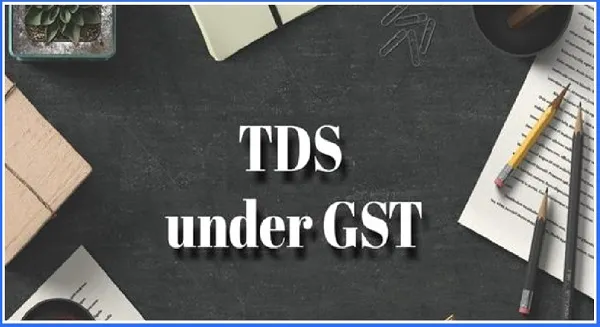Tax deduction at source, i.e., giving the receiver money after deducting tax from it. Taxes have been an age-old concept. But, its inception in GST is quite recent. Now, the notified classes of persons are required to comply with provisions of TDS under GST.https://www.gst.gov.in/
TDS (Tax Deducted at Source) is a mechanism under Goods and Services Tax (GST) in which the payer deducts a specified percentage of tax from the payment made to the recipient. The payer then deposits this tax amount with the government.
TCS (Tax Collected at Source) is another provision under GST in which the seller or service provider collects a specified percentage of tax from the buyer or recipient and deposits the collected tax amount with the government.
TDS and TCS in GST were introduced in the Goods and Service Tax regime on October 1, 2018. Like the Income Tax laws, these provisions aim to collect tax at the source, contributing to revenue collection and compliance.

What is TDS in GST?
Tax Deducted at Source (TDS) under GST requires the recipient of certain goods or services to deduct a portion of the payment as tax and remit it to the government. GST law specifies who must deduct TDS, the applicable tax rate, and the payment procedure.
Who is liable to deduct TDS under GST law?
- A department or an establishment of the Central Government or State Government; or
- Local authority; or
- Governmental agencies; or
- Such persons or categories of persons as may be notified by the Government.
As per the latest Notification dated 13th September 2018, the following entities also need to deduct TDS-
- An authority or a board or any other body which has been set up by Parliament or a State Legislature or by a government, with 51% equity ( control) owned by the government.
- A society established by the Central or any State Government or a Local Authority and the society is registered under the Societies Registration Act, 1860.
- Public sector undertakings.
Registration requirements for TDS deductors
Anyone liable to deduct TDS is required to register, regardless of any threshold limit. This GST registration can be obtained using an existing Tax Deduction and Collection Account Number (TAN) issued under the Income Tax Act, even without a PAN. Therefore, possessing a TAN is mandatory for TDS deductors.
Is there any exemption to the applicability of TDS in GST?
The only exception GST law provides for the applicability of TDS in GST is when the location of the supplier and place of supply is different from the place of registration of the recipient.
For eg, Supplier is located in Rajasthan, and on the instruction of the recipient (located in Gujarat), the supply is made to a person in Rajasthan itself. In such a case, it would be difficult to transfer TDS, i.e., CGST and SGST of Rajasthan, to the cash ledger of the supplier, i.e., CGST and SGST of Gujarat. Hence, this transaction has been kept outside the purview of TDS under GST.
TDS certificate under GST
The party responsible for deducting TDS (the recipient of goods or services) must provide a TDS certificate to the party whose payment was reduced by the TDS amount (the supplier of goods or services). This certificate must be issued within five days of the tax being paid to the government.
Under GST law, this TDS certificate is issued using Form GSTR-7A. This form is automatically generated on the GST portal based on the GSTR-7 return filed by the TDS deductor. Therefore, timely filing of the GSTR-7 return by the deductor is essential. Form GSTR-7A is accessible to both the supplier and the recipient.
Form GSTR-7A contains the following information:
- The TDS certificate number
- The name and GSTIN of the tax deductor (recipient)
- The GSTIN of the party whose tax was deducted (supplier)
- The value of the supply, the TDS rate, and the TDS amount
- The period during which the tax was deducted and paid to the government
- Other relevant details
This TDS certificate allows the government to verify the accuracy of the deducted tax amount and ensure that the TDS amount shown in the TDS return matches the amount reflected in the electronic cash ledger.
The TDS return and certificate process under the Goods and Services Tax system is analogous to the Income Tax return and Form 26AS process in the direct tax system. Both systems serve to reconcile the amount of tax deducted at source with the amount deposited with the government.
FAQs
When is TDS required to be deducted?
TDS (Tax Deducted at Source) is required on transactions where the total value of goods or services received under a single contract exceeds Rs 2,50,000. This applies even if individual goods or services within the contract are valued at less than Rs 2,50,000.
When calculating the TDS amount, exclude any CGST, SGST, IGST, or cess components from the total supply value. This ensures that TDS is not deducted from the tax component itself, aligning with the GST principle of avoiding tax on tax.
What is the rate of TDS under GST?
Under the Goods and Services Tax (GST) regime in India, Tax Deducted at Source (TDS) is required to be deducted at the rate of 2% on payments made to the supplier of taxable goods and/or services by certain notified persons. This 2% is split into 1% CGST and 1% SGST or 2% IGST.
The TDS is applicable when the total value of supply under a contract exceeds ₹2,50,000. This means that if the value of a single contract is more than ₹2,50,000, TDS must be deducted.